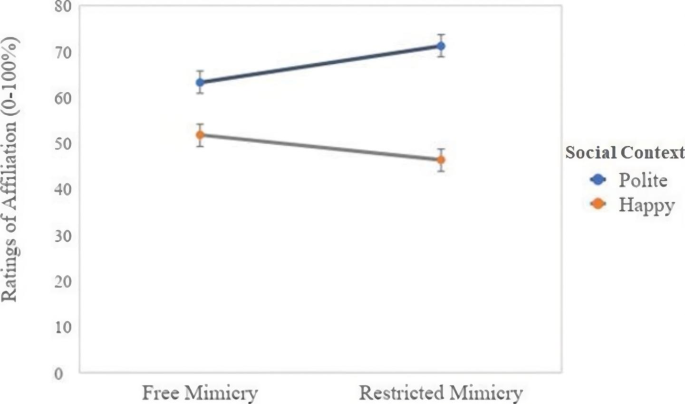Facial Mimicry and Social Context Affect Smile Interpretation
IF 1.7
3区 心理学
Q4 PSYCHOLOGY, SOCIAL
引用次数: 4
Abstract
Abstract Theoretical accounts and extant research suggest that people use various sources of information, including sensorimotor simulation and social context, while judging emotional displays. However, the evidence on how those factors can interplay is limited. The present research tested whether social context information has a greater impact on perceivers’ smile judgments when mimicry is experimentally restricted. In Study 1, participants watched images of affiliative smiles presented with verbal descriptions of situations associated with happiness or politeness. Half the participants could freely move their faces while rating the extent to which the smiles communicated affiliation, whereas for the other half mimicry was restricted via a pen-in-mouth procedure. As predicted, smiles were perceived as more affiliative when the social context was polite than when it was happy. Importantly, the effect of context information was significantly larger among participants who could not freely mimic the facial expressions. In Study 2 we replicated this finding using a different set of stimuli, manipulating context in a within-subjects design, and controlling for empathy and mood. Together, the findings demonstrate that mimicry importantly modulates the impact of social context information on smile perception.

面部模仿和社会背景影响微笑的解释
理论解释和现有研究表明,人们在判断情绪表现时使用各种信息来源,包括感觉运动模拟和社会背景。然而,这些因素如何相互作用的证据是有限的。本研究测试了在实验中,当模仿受到限制时,社会背景信息是否对感知者的微笑判断有更大的影响。在研究1中,参与者观看了与快乐或礼貌相关的情景的语言描述的亲切微笑的图像。一半的参与者可以自由地移动他们的脸,同时评估微笑传达从属关系的程度,而另一半的模仿则通过嘴插笔的程序受到限制。正如预测的那样,当社交环境是礼貌的时候,微笑被认为比在社交环境是快乐的时候更有亲和力。重要的是,情境信息的影响在不能自由模仿面部表情的参与者中明显更大。在研究2中,我们使用一组不同的刺激重复了这一发现,在受试者内部设计中操纵上下文,并控制移情和情绪。总之,研究结果表明,模仿重要地调节了社会背景信息对微笑感知的影响。
本文章由计算机程序翻译,如有差异,请以英文原文为准。
求助全文
约1分钟内获得全文
求助全文
来源期刊

Journal of Nonverbal Behavior
PSYCHOLOGY, SOCIAL-
CiteScore
4.80
自引率
9.50%
发文量
27
期刊介绍:
Journal of Nonverbal Behavior presents peer-reviewed original theoretical and empirical research on all major areas of nonverbal behavior. Specific topics include paralanguage, proxemics, facial expressions, eye contact, face-to-face interaction, and nonverbal emotional expression, as well as other subjects which contribute to the scientific understanding of nonverbal processes and behavior.
 求助内容:
求助内容: 应助结果提醒方式:
应助结果提醒方式:


